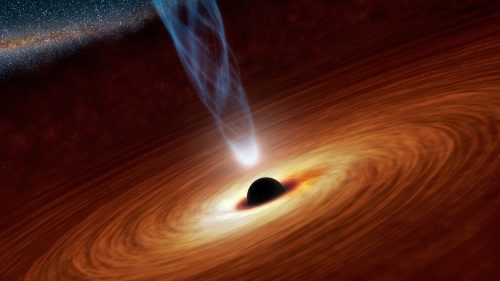Scientists from the Weizmann Institute explain where the "missing link" of black holes has gone

A black hole is a celestial body so compressed that its gravity "folds" the space around it in such a way that any object that approaches it and crosses a boundary called the "event horizon", disappears beyond this horizon forever - and is swallowed up in the hole. This is how the black hole grows by swallowing interstellar gas and stars. The nickname "black hole" reflects the fact that even light radiation is absorbed in it, and cannot escape, therefore it is completely dark. Although the black hole is not visible, its enormous gravity also affects far from the event horizon, and shifts the orbits of the objects around it.
Two types of black holes are known to exist in the universe. One is "light" black holes, whose mass is about ten times that of our Sun; These "light" holes are created as a result of the collapse of massive stars that collapse in on themselves. The second type are supermassive black holes, whose mass is a million to a billion times greater than the mass of the Sun. Such supermassive black holes are found in the cores of galaxies. Such a supermassive black hole is also in the center of our galaxy - the Milky Way galaxy.
It is not clear how the supermassive black holes are formed and develop, but many scientists assume that they develop from much lighter "seeds", which may have formed in the extreme conditions that prevailed in the early universe, and it is possible that those seeds were the light black holes we know. Either way, it is believed that the gradual growth of black holes from light seeds also includes various intermediate stages, that is, there should also be black holes in the wide range of masses between the light and supermassive black holes: "medium" black holes with masses between one hundred and one hundred thousand masses sun. Indeed, shortly after the discovery of the supermassive black holes in the 60s of the last century, searches began for the "missing link" - medium black holes. But completely contrary to expectations, decades of observations and measurements brought up clay. To this very day, not even one medium black hole has been discovered and identified with certainty in the universe.
The mystery of the absence of medium-sized black holes is very disturbing both because it indicates large gaps in our understanding of the basic processes in the evolution of galaxies - and because many hypotheses have been put forward based on the existence of medium-sized black holes. For example, theoretical calculations predict that intermediate black holes should play an important role in transmitting observable and measurable bursts of light and gravitational waves, by destroying stars through their absorption.
We predict that in our cosmic age all seeds will have already turned into supermassive black holes. In order to discover medium-sized black holes, the observations will have to improve and extend visibility into the early cosmic era in which the seeds were formed, before they had time to grow."
This state of affairs is changing these days, thanks to a new study by Prof. Tal Alexander from the Weizmann Institute and his former student Dr. Ben Bar-Or from the Institute for Advanced Studies in Princeton. In the article thatPublished in the scientific journal Nature Astronomy, Prof. Alexander and Dr. Bar-Or were able to show that, given some reasonable assumptions, the light seeds will "eat" the stars around them at a rapid rate that will eventually bring them to a mass close to one million solar masses - the known lower limit of the mass of supermassive black holes. Furthermore, Prof. Alexander and Dr. Bar-Or showed that this result is general: it does not depend on the unknown initial mass of the seed or the unknown cosmological age in which it was formed.
Prof. Alexander adds: "The calculations we made, which are based on the theory of the evolution of stellar motion around a black hole and a number of other assumptions, show that the process of the 'losing' of the light seed in the stars is inevitable. If in addition to that, the black hole also 'ate' gas, or black holes smaller than it, then it will be even more massive today. Thus, we predict that in our cosmic age all seeds will have already turned into supermassive black holes. In order to discover medium-sized black holes, the observations will have to improve and extend visibility into the early cosmic era in which the seeds were formed, before they had time to grow."
See more on the subject on the science website:
- A third gravitational wave event has been discovered; Confirms the existence of a new type of black holes
- Researchers present a new explanation for the emission of energy and winds from black holes
- Black holes, wormholes and the secrets of quantum space-time
- For the first time, two huge black holes were discovered in the galaxy, and it is estimated that they will collide
- Does time inside black holes move backwards?

4 תגובות
There is evidence of medium-sized black holes
https://en.wikipedia.org/wiki/Intermediate-mass_black_hole
They cannot be seen.
Today's seeds will no longer become massive black holes.
The intention was that seeds that started the process of accumulating additional mass ended the process in our existence
Raphael is right, something here doesn't make sense.
In my opinion, the medium holes must exist and it is only a problem with our abilities to discover them.
"We predict that in our cosmic age all seeds will have already turned into supermassive black holes"
If this were true then "seeds" would not be found today either.